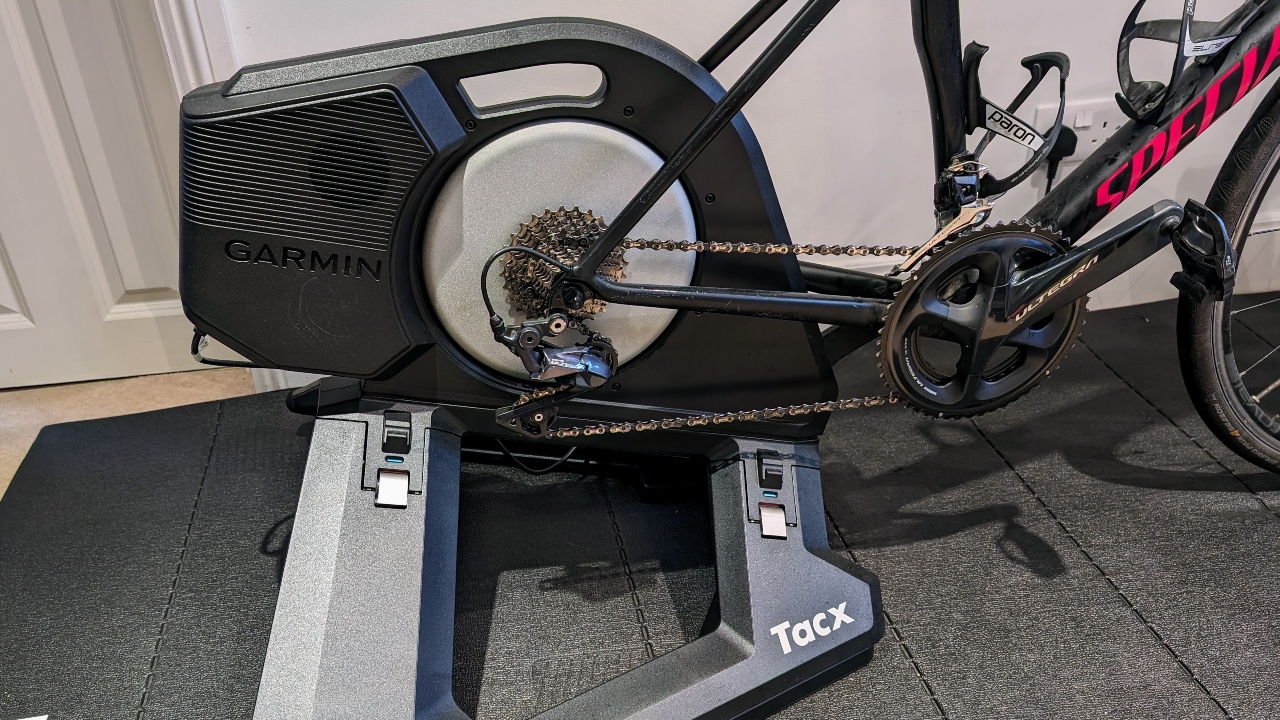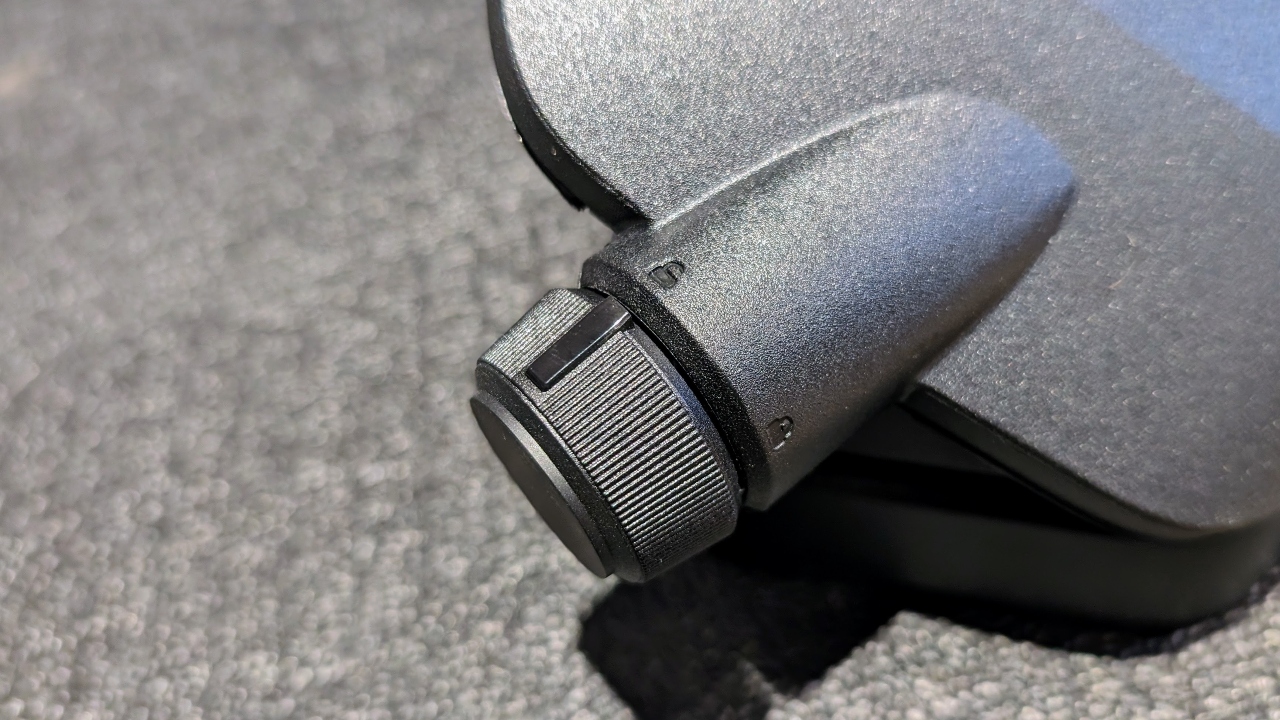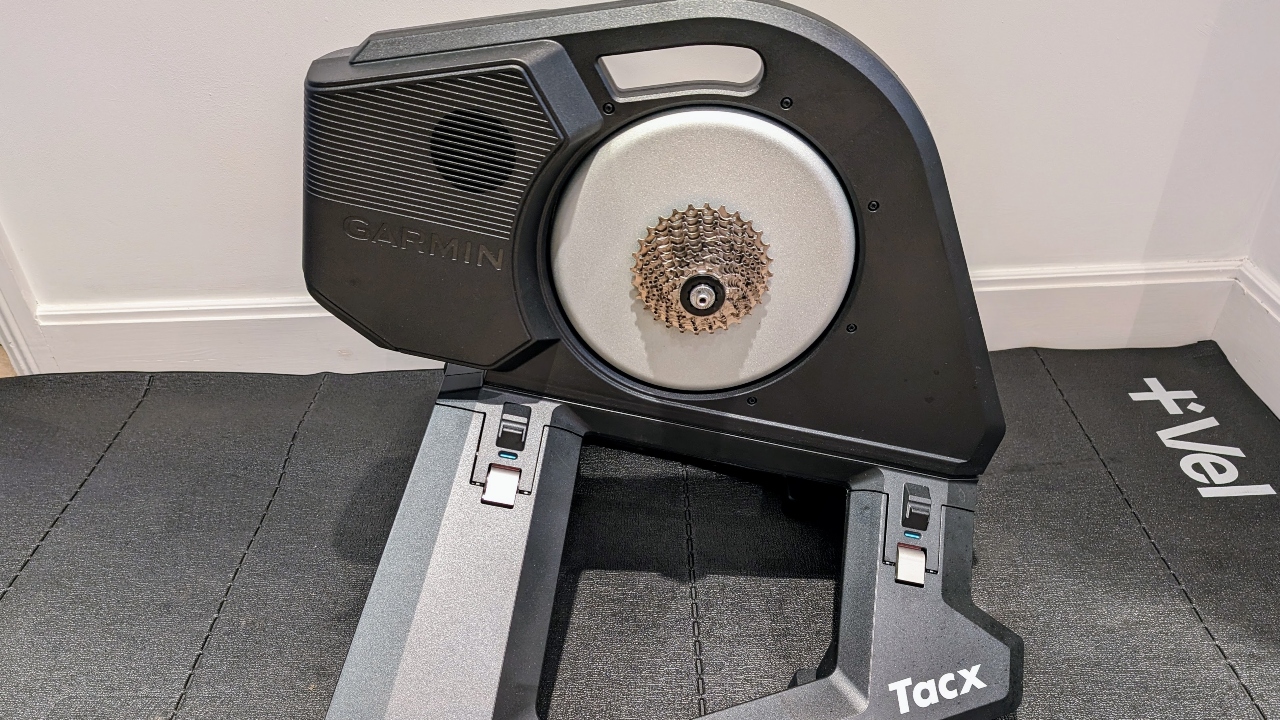Our Verdict
The Tacx Neo 3M goes toe-to-toe with Wahoo’s Kickr Move, but the brand’s premium offering comes at a serious investment.
For
- Unrivaled power and gradient specs
- Range of movement contributes to realistic ride feeling
- Quick setup
Against
- Expensive
- Cheaper alternatives
- Newer, 12-speed bikes not compatible out of the box
- No Wi-Fi connectivity
You can trust Coach
The high-end turbo trainer race has been hotting up in the last six months, with manufacturers adding exciting features to entice new customers and prompt indoor-cycling converts to upgrade their machines.
In September 2023 Wahoo released the Kickr Move, an upgrade to its respected Kickr platform. It integrated 8in/20cm fore-aft (forward and backward) movement into the turbo trainer, removing the need to use an accessory to allow the rider to experience lateral and front and back motion. Tacx wasn’t far behind and launched the Neo 3M in December 2023. This features 2in/5cm of fore-aft, as well as several upgrades to the Neo 2T, which came out in 2019.
However, is the addition of 2in/5cm of movement worth paying for? Or is it a fad, and something indoor cyclists can live without? I tested one to find out.
Tacx Neo 3M: Price And Availability

The Tacx Neo 3M was released in December and costs $1,999.99 in the US and £1,749.99 in the UK. Its main competition, the Wahoo Kickr Move, costs $1,599.99/£1,399.99. It’s possible to buy a Tacx Neo 2T for $1,399.99/£1,199.99 and the Tacx Neo Motion Plates ($299.99/£259.99) to acquire a similar set-up for less.
How I Tested This Turbo Trainer
I’ve logged about 10 hours of turbo training on the Neo 3M. I performed a mixture of ERG-led interval-based workout sessions on the training apps Zwift and TrainerRoad, and completed a resistance-based FTP test and spent time free-riding on Zwift. I’ve experience of the best turbo trainers and smart bikes, including the Wahoo Kickr Bike and the Tacx Neo 2T, as well as mid-range options such as the Zwift Hub and Wahoo Kickr Core.
Features

The headline feature of the Neo 3M is the fore-aft addition, though the improvements run deeper than this. The unit has more lateral movement than its predecessor, allowing you to throw the bike from side to side when out of the saddle on a virtual climb or performing sprints. It adds gravel to its simulated terrains (previously limited to cobblestones), helping improve immersion when riding off-road virtually.
The other main upgrade is the inclusion of a pre-installed cassette, although if you don’t own a Shimano/SRAM 11-speed drivetrain you’ll need to pay extra for the correct driver. The Neo 3M can be paired with the Tacx Smart Network Adapter to provide a more secure connection to cycling training apps via Wi-Fi or an Ethernet cable, although this also means an additional cost.
Sign up for workout ideas, training advice, reviews of the latest gear and more.
Otherwise, everything is the same as on the Tacx Neo 2T, including its maximum gradients and power (25% and 2200W). I can’t see a situation where you’d want to attempt more than either of those when riding indoors. Its accuracy on power, speed, and cadence is a solid +/- 1%, and it can still be used without a power source and doesn’t require calibrating. The trainer can be folded away when not in use, although you’ll have to remove your bike to do that.
The Set-Up
If you’ve spent more than $1,000/£1,000 on a turbo trainer it should be ready to use immediately. That wasn’t the case with the Neo 2T, which required the installation of a cassette (either a separate purchase, or the one from your bike’s rear wheel), and the additional costs involved.
Tacx has learned from this mistake and supplies the Neo 3M with an 11-speed cassette installed. If you have the correct Shimano/SRAM drivetrain (which most road bikes sold in the past 10 years or so will), then you can be set up and riding in under 10 minutes. The trickiest part is choosing which workout to do first.

The trainer isn’t perfect though. Twelve-speed drivetrains have trickled down to most 2024-release mid-range road bikes, which require you to swap the pre-installed cassette; if you have a mountain bike, expect to purchase the correct driver for an additional cost. It’s understandable that turbo trainers are made in a factory to mostly universal specifications, but in an ideal world Tacx would offer alternative set-ups free of charge—albeit with a slightly longer lead time.
Once your bike is installed, you can modify settings, such as road feel intensity and grade resistance (how realistic climbs feel) using the free Tacx Training app. One thing to note is that the fore-aft setting is locked out of the box, but you simply twist two dials at the rear of the turbo trainer to add forward and backward movement to your indoor riding.
The Ride
Turbo trainers are judged on how realistic the ride feels and the Neo 3M is one of the closest simulations of real-world riding I’ve tested. Its lateral movement is an improvement on its predecessor and allowed for a more natural throwing of the bike from side to side than the Axis feet of Wahoo’s Kickr. The benefit is increased movement in the saddle, getting you moving around on the bike as you would on the road and minimizing sore spots from sitting in one position for too long.
However, the fore-aft was less noticeable, and I don’t think it added much to the overall experience. In fact, I preferred the Neo 3M when riding with the fore-aft setting locked.
Its magnet-based virtual flywheel remains one of the best around. When used in ERG mode, the gradual changes in resistance were fast enough to get the desired effect of an interval, but not so fast that it felt like you were suddenly riding through treacle when going from easy to hard. In free-ride mode, the turbo trainer’s simulation of road surfaces via haptic feedback felt realistic but still seems like a gimmick, with only a smattering of “non-tarmac” surfaces on indoor training programmes like Zwift.
Is the Tacx Neo 3M Worth It?

There’s no hiding from the fact that the Neo 3M is expensive. It costs more than its direct competitor (Wahoo Kickr Move) and, without built-in Wi-Fi and less actual fore-aft movement, has fewer features than its rival. If you’re on team Tacx, you may be happy to pay the premium, but I don’t think it does enough to justify the extra cost. In fact, it’s possible to get one of the best turbo trainers, like the Wahoo Kickr Core or Zwift Hub, and invest in a rocker plate accessory for a similar ride feel for a fraction of the price.
The Neo 3M is a welcome upgrade on the Neo 2T, but doesn’t shift the dial enough to overtake Wahoo’s offerings at the premium end of the turbo trainer market. The addition of fore-aft movement isn’t worth upgrading for, while the inclusion of a pre-installed cassette should be the minimum at this price. The lack of built-in Wi-Fi is a shortcoming that will raise eyebrows among serious Esports racers and those who want to minimize signal drop-outs during workouts and rides.
Charlie Allenby is a journalist with a passion for pedalling. He contributes features and buying advice about cycling, and is Coach’s dedicated turbo trainer reviewer. He is also Coach’s chief whey and casein protein powder tester, trying as many brands as possible.
Charlie’s first book, Bike London, is out now. He has written for The Guardian, The Independent and BikeRadar, among others.


